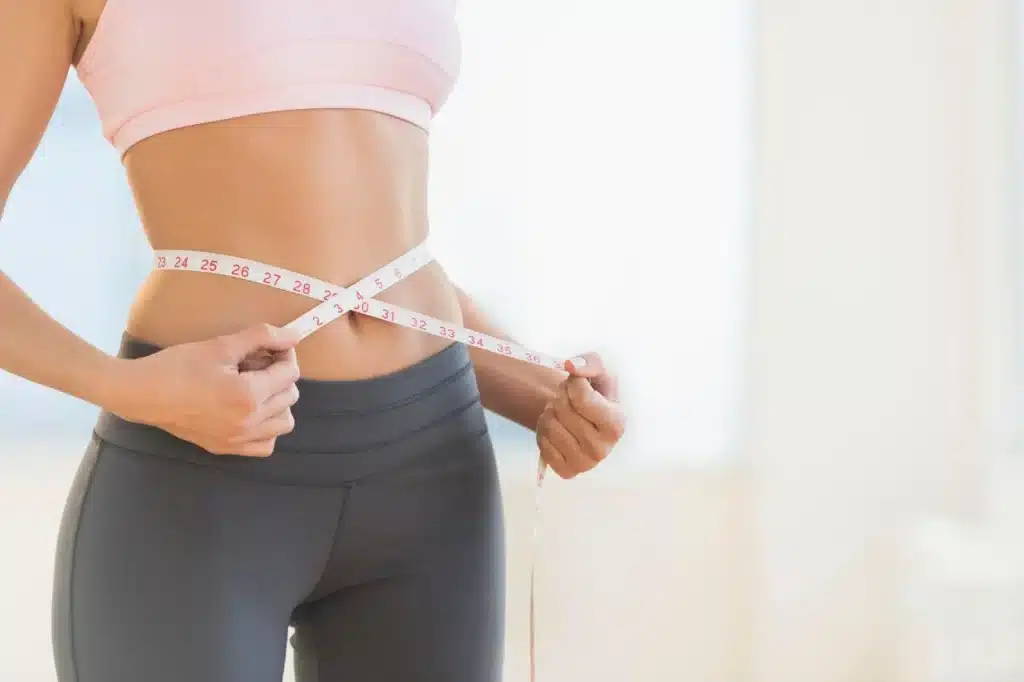Introduction
What Measurements To Take For Weight Loss: Weight loss is not a one-size-fits-all endeavor. It’s a complex process influenced by various factors such as genetics, metabolism, lifestyle, and overall health. Consequently, taking accurate measurements to track progress and make informed decisions is crucial. These measurements provide individuals with a clear picture of their starting point and help them set realistic goals, track their progress, and make necessary adjustments to their weight loss strategies.
It will explore the essential measurements that should be considered when embarking on a weight loss journey. These measurements go beyond the conventional bathroom scale and delve into a more comprehensive understanding of one’s body composition, health markers, and overall well-being.
Among the measurements to be discussed are body weight, body mass index (BMI), body fat percentage, waist circumference, and even non-physical markers like energy levels and mood. Understanding these metrics not only allows individuals to monitor physical progress but also helps them make informed decisions about diet, exercise, and other lifestyle changes.
The importance of setting realistic and sustainable goals. Weight loss is not a sprint but a marathon, and taking appropriate measurements can help individuals avoid common pitfalls like crash diets and extreme exercise regimens that may yield short-term results but are often unsustainable and unhealthy in the long run.

How do you measure your waist for fat loss?
Waist circumference: Wrap a flexible measuring tape around the natural waist (in between the lowest rib and the top of the hip bone), the umbilicus (belly button), or at the narrowest point of the midsection.
Measuring your waist for fat loss is a valuable way to track your progress on your weight loss journey. The waist measurement is an essential indicator of changes in body composition, specifically the reduction of abdominal fat, which is associated with various health benefits. Here’s a guide on how to measure your waist for fat loss effectively:
Gather the Right Tools:
To accurately measure your waist, you’ll need a flexible, non-stretchable measuring tape. Make sure it’s long enough to go around your waist comfortably.
Find the Right Location:
Locate your natural waistline, which is typically just above your belly button. This is the point where you should take the measurement.
Wear Appropriate Clothing:
For consistent measurements, wear form-fitting clothing or measure your waist without clothing, if possible. Avoid measuring over bulky clothing that can skew the results.
Stand in a Relaxed Position:
Stand up straight in a relaxed, neutral position, with your feet together and arms at your sides. Avoid sucking in your stomach or holding your breath.
Wrap the Measuring Tape:
Gently wrap the measuring tape around your waist at the natural waistline. Ensure the tape is snug but not so tight that it compresses your skin or makes an indentation.
Take the Measurement:
While keeping the tape parallel to the ground, take the measurement in inches or centimeters. Record the measurement.
Repeat for Accuracy:
To ensure accuracy, it’s a good practice to take multiple measurements at different times and days, and then calculate an average. This helps account for natural fluctuations in waist size due to factors like hydration and digestion.
What measurements do you use for weight?
Customary Units of Weight Measurement
The US customary units for measuring weight are ounces, pounds, and tons. Ounce: An ounce is an imperial measure of weight. It is abbreviated as oz. An ounce is equivalent to 28.35 grams.
When it comes to monitoring and managing your weight effectively, it’s essential to consider various measurements beyond just the number on the scale. These additional measurements provide a more comprehensive view of your body composition, overall health, and progress on your weight management journey. Here are some key measurements to use for a well-rounded approach to weight:
Body Weight:
Body weight is the most straightforward measurement and is typically the first one that comes to mind. It reflects your total mass, including muscle, fat, bone, and water weight. Regularly tracking your weight can help you monitor trends and identify changes over time.
Body Mass Index (BMI):
BMI is a simple calculation that uses your weight and height to estimate your body fat. While it’s not a perfect measure of health due to its simplicity, it can provide a general guideline for whether you’re in a healthy weight range or at risk for obesity-related health issues.
Body Fat Percentage:
Measuring your body fat percentage provides a more accurate assessment of your body composition. It distinguishes between fat and lean mass. Various methods, including skinfold calipers, bioelectrical impedance, and DEXA scans, can be used to determine body fat percentage.
Waist Circumference:
As mentioned in a previous response, measuring your waist circumference is crucial for tracking abdominal fat, which is linked to health risks such as heart disease and diabetes. It’s an indicator of visceral fat, the kind of fat that surrounds your internal organs.
Hip Circumference:
Measuring your hip circumference in relation to your waist circumference can provide insights into your body’s fat distribution. This can be important, as it helps identify whether you have an apple-shaped (more fat around the abdomen) or pear-shaped (more fat around the hips and thighs) body type.
Blood Pressure:
High blood pressure (hypertension) is a risk factor for various health conditions, including heart disease and stroke. Regularly monitoring your blood pressure can help you assess your cardiovascular health, which is closely linked to weight management.
How Often Should I Take Measurements When Losing Weight?
It’s wise to take measurements every 2 to 4 weeks to see how your efforts are affecting your body composition while you are actively trying to build muscle, manage your weight, or both. If you are trying to maintain your results, taking measurements every month or two should suffice.
The frequency at which you should take measurements when losing weight depends on several factors, including your individual goals, the specific measurements you’re tracking, and your overall approach to weight loss. Here are some guidelines to help you determine how often you should take measurements:
Initial Baseline Measurements:
When starting your weight loss journey, it’s crucial to establish a baseline by taking initial measurements. This provides a starting point to track progress effectively. Take these baseline measurements before making any significant changes to your diet or exercise routine.
Weekly or Biweekly:
For many individuals, tracking weight loss progress on a weekly or biweekly basis can be helpful. This frequency allows you to monitor trends and make adjustments to your plan if needed. It also helps you stay motivated by seeing consistent progress or identifying areas that may require more attention.
Monthly:
Some measurements, such as body fat percentage and waist circumference, may not change significantly on a week-to-week basis. In such cases, taking measurements monthly can be sufficient. Monthly measurements provide a broader view of your progress while reducing the potential for frustration caused by minor fluctuations.
Photos:
Alongside measurements, consider taking monthly progress photos. Visual comparisons can be powerful motivators, as they provide a clear visual representation of your transformation. Make sure to take these photos under consistent lighting and clothing conditions for accurate comparisons.
Fitness Milestones:
If you have fitness-related goals, such as running a specific distance or lifting a certain weight, you may want to track these milestones separately. Assess your progress in these areas based on your training plan and timeline.
Listen to Your Body:
While measurements are valuable, it’s essential to pay attention to how you feel. Improved energy levels, better sleep, and enhanced mood can be signs of progress even if your measurements don’t change as quickly as you’d like.
Consider Your Goals:
The frequency of measurements should align with your weight loss goals. If you have a specific target date in mind, you may choose to measure more frequently to stay on track. On the other hand, if you’re focused on long-term, sustainable changes, less frequent measurements may suffice.
Is It Better To Lose Inches Or Weight First?
Several medical studies note the importance of losing inches around the waist over just losing weight. They’ve found it’s far more unhealthy to carry belly fat than it is to have fat deposited just under the skin.
It’s better to lose inches or weight first when embarking on a fitness or weight loss journey is a common one, and the answer often depends on individual goals and circumstances. Both weight loss and losing inches (reducing body measurements) have their merits, and the choice between the two should align with your objectives and overall health considerations.
Losing Weight First:
Health Benefits: Focusing on weight loss, particularly if you are significantly overweight or obese, can provide substantial health benefits. Shedding excess pounds can reduce the risk of obesity-related conditions like heart disease, diabetes, and high blood pressure.
Motivation: For many people, seeing the number on the scale decrease can be a motivating factor. Weight loss milestones can provide a sense of achievement and encouragement to continue your efforts.
Quicker Progress at the Beginning: When you start a new diet or exercise routine, you often experience rapid initial weight loss due to factors like water retention. This can provide an immediate sense of accomplishment.
Losing Inches First:
Body Composition Improvement: Focusing on losing inches or body fat can lead to improved body composition, even if the scale doesn’t show a significant change. This means you may be losing fat while maintaining or even gaining muscle, resulting in a leaner and more toned appearance.
Improved Confidence: Seeing changes in your body measurements, such as a smaller waist or slimmer thighs, can boost your self-confidence and body image, which are essential for long-term motivation.
Sustainable Approach: Losing inches tends to be a more sustainable and long-term approach to health and fitness. It often involves adopting a balanced diet and exercise routine that you can maintain over time.
The Ideal Approach:
The ideal approach often combines both weight loss and losing inches. Weight loss can be an initial goal for those who need to reduce their overall body mass for health reasons. Once you’ve made progress in this area, shifting your focus to losing inches and improving body composition can help you achieve a more toned and healthier physique.
It’s also essential to remember that the scale doesn’t tell the whole story. Weight fluctuates for various reasons, including water retention, muscle gain, and hormonal changes. Therefore, relying solely on the scale can be misleading. Instead, use a combination of measurements, such as body fat percentage, waist circumference, and how your clothes fit, to gauge your progress accurately.
What Is The Best Time To Scale For Weight Loss?
First thing in the morning
The thing that’s most important when it comes to weighing yourself, either weekly or daily, is at what time. Most researchers agree that it’s best to weigh yourself first thing in the morning.
The best time to step on the scale for weight loss can be a matter of personal preference and daily routines, but there are some general guidelines to consider. Timing can affect the accuracy of your weight measurements, and understanding these factors can help you make the most of your weigh-ins:
Consistency is Key: The most important factor is to be consistent with when you weigh yourself. Choose a specific time of day and stick to it. This consistency helps you track your progress more accurately by minimizing the impact of daily fluctuations.
Morning Weigh-Ins: Many people prefer to weigh themselves in the morning, right after waking up and after using the bathroom. This is because your weight tends to be at its lowest point in the morning, before you’ve eaten or had significant fluid intake. It also provides a consistent baseline measurement.
Empty Stomach: Weighing yourself before breakfast, or at least a few hours after your last meal, can provide a more accurate reading. Food and fluid intake can temporarily increase your weight due to digestion and hydration.
Same Clothing (or None): For consistency, weigh yourself in the same or no clothing each time. Clothing can add variable weight, so if you choose to wear something, make sure it’s lightweight.
Weekly or Biweekly: Many health experts recommend weighing yourself no more than once a week or every two weeks. Daily fluctuations can be frustrating and may not accurately reflect your long-term progress. Weekly weigh-ins provide a more stable trend.
Mental State: Try to weigh yourself when you’re in a relaxed mental state. Stress, anxiety, and fatigue can lead to temporary weight fluctuations due to hormonal changes and increased fluid retention.
What Are The Three Types Of Body Measurements?
Bust/waist/hip measurements (informally called ‘body measurements’ or ′vital statistics′) are a common method of specifying clothing sizes. They match the three inflection points of the female body shape.
Body measurements are valuable tools for assessing and tracking various aspects of your physical health and fitness. There are three primary types of body measurements that individuals commonly use to monitor their well-being:
Anthropometric Measurements:
Anthropometric measurements involve the physical dimensions and proportions of the human body. These measurements are typically used to assess body size and composition. Common anthropometric measurements include:
Height: Measured in inches or centimeters, height is a fundamental anthropometric measurement used to assess growth and monitor changes in stature.
Weight: Body weight, usually measured in pounds or kilograms, provides an overall measure of mass. It’s a critical indicator of changes in body composition, including fat and muscle mass.
Body Mass Index (BMI): BMI is a formula that relates weight to height and is used to estimate an individual’s level of body fat. While it has limitations and doesn’t directly measure body fat, it’s a widely used tool to assess weight-related health risk.
Circumference Measurements:
Circumference measurements involve the girth or circumference of specific body parts and are used to assess changes in body shape and fat distribution. Common circumference measurements include:
Waist Circumference: Measured around the waist at the level of the navel, waist circumference is a key indicator of abdominal fat and is associated with health risks such as heart disease and diabetes.
Hip Circumference: Measured around the widest part of the hips and buttocks, hip circumference is used in conjunction with waist circumference to assess body fat distribution. The waist-to-hip ratio is a related measurement used to evaluate health risks.
Skinfold Measurements:
Skinfold measurements involve the thickness of skin and underlying fat at specific sites on the body. Skinfold calipers are commonly used to measure skinfold thickness, allowing for an estimate of subcutaneous fat. Common skinfold measurement sites include:
Triceps: Measuring the skinfold thickness on the back of the upper arm.
Suprailiac: Measuring the skinfold thickness just above the hip bone.
Abdominal: Measuring the skinfold thickness at the level of the navel.
Thigh: Measuring the skinfold thickness on the front of the thigh.
Calf: Measuring the skinfold thickness on the back of the lower leg.
These three types of body measurements provide a comprehensive view of an individual’s body size, composition, and distribution. When used together and over time, they can help track changes in health and fitness, assess progress in weight management and fitness goals, and identify areas that may require attention for a balanced and healthy lifestyle.
What Is My True Weight Morning Or Night?
You’ll get the most accurate reading from your scale if you weigh yourself first thing in the morning after using the restroom and before your breakfast or first chug of water.
The concept of your “true weight” in the morning versus at night can be somewhat misleading, as your body weight naturally fluctuates throughout the day due to various factors. It’s essential to understand that these fluctuations are entirely normal and don’t necessarily reflect your actual weight or overall health. Here’s why your weight may differ between morning and night:
Hydration Levels: One of the most significant factors contributing to weight fluctuations is changes in hydration levels. You typically lose water throughout the day through activities like sweating, urination, and respiration. This can result in a lower body weight in the morning when you’re relatively dehydrated compared to the evening.
Food Intake: The food and fluids you consume throughout the day contribute to your body weight. After meals and snacks, your weight may temporarily increase due to the weight of the food and water you’ve consumed. This effect is most noticeable in the hours following a meal.
Digestive Processes: The digestive process itself can influence your weight. As your body breaks down and absorbs nutrients from food, there can be variations in the contents of your digestive tract, which can affect your overall weight.
Physical Activity: Physical activity, including exercise, can lead to temporary weight fluctuations. After a workout, you may weigh slightly less due to fluid loss through sweating, but this weight loss is typically temporary and related to dehydration.

Conclusion
The measurements to take for weight loss is pivotal on your journey to a healthier and more fulfilling life. Weight loss is not merely about the number on the scale; it’s a multifaceted process that involves various aspects of your physical and mental well-being.
While often the most apparent measurement, body weight is just one piece of the puzzle. Regularly tracking your weight can provide a broad overview of your progress, but it doesn’t tell the whole story. BMI can help you estimate your body fat percentage and assess whether you’re within a healthy weight range. However, it has limitations and should be used in conjunction with other measurements.
Measuring body fat percentage is essential for a more accurate understanding of your body composition. It distinguishes between fat and lean mass, helping you track changes in your physique. Waist circumference is a critical measurement for evaluating abdominal fat, which is associated with increased health risks. It offers insights into changes in fat distribution.

